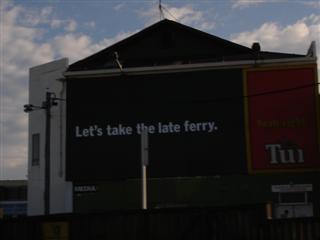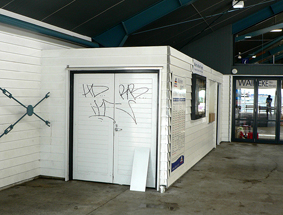Please show your support of Waihekepedia by adding a link to us from your web site. Waihekepedia T Shirts now available at the Ostend Market
Difference between revisions of "Fullers Group Limited"
Countrymike (talk | contribs) m |
|||
| (22 intermediate revisions by 6 users not shown) | |||
| Line 1: | Line 1: | ||
| − | Fullers Group Limited | + | Fullers Group Limited is a group of companies emerged from the progressive amalgamation of a number of maritime transport and marine engineering companies based on the Waitemata Harbour and [[Hauraki Gulf]]. Its present configuration of 9 vessels now transport over 3.9 million passengers a total of 46.6 million passenger kilometres each year on scheduled services. |
| − | Buying Leo Dromgoole's fleet of boats was the start for Fullers. It was developed under the guidance of former owner George Hudson, whose son Doug Hudson is still at the helm administratively. | + | == Company history and ownership == |
| + | Buying Leo Dromgoole's fleet of boats was the start for Fullers. It was developed under the guidance of former owner [[George Hudson]], whose son Doug Hudson is still at the helm administratively. The company was bought out in the mid-2000s by Scottish-based Stagecoach, whose New Zealand interests (buses and ferries) have been bought by infrastructure company [[Infratil]] in 2005 for $253 million. Fullers Ferries have been [http://www.nzherald.co.nz/business/news/article.cfm?c_id=3&objectid=10565582 sold] by Infratil to Souter Holdings in April 2009 for $40 million. | ||
| − | + | == Vessels == | |
* [[Adventurer]] | * [[Adventurer]] | ||
| − | * Harbour Cat | + | * [[Harbour Cat]] |
* [[Jet Raider]] | * [[Jet Raider]] | ||
| − | * Kea | + | * [[Kea]] |
* [[Quickcat]] | * [[Quickcat]] | ||
| − | * Quickcat II | + | * [[Quickcat II]] |
| − | * Seaflyte | + | * [[Seaflyte]] |
| − | * Starflyte | + | * [[Starflyte]] |
* [[Superflyte]] | * [[Superflyte]] | ||
| − | * Tiger Cat | + | * [[Tiger Cat]] |
| + | * [[Wanderer II]] | ||
| − | The company's timetable for its Waiheke run can be found [http://www.fullers.co.nz/index.php/pi_pageid/ | + | The company's timetable and fare structure for its Waiheke run can be found [http://www.fullers.co.nz/index.php/pi_pageid/210 here]. |
| + | |||
| + | == Passenger fares and controversies == | ||
| + | |||
| + | The [[Matiatia]] to [[Auckland]] ferry service is the biggest volume commuter and tourist service in New Zealand and operates on a private monopoly basis without local subsidies. | ||
| + | A current monthly ferry pass, which includes transport on [[Waiheke Bus Company]] and [[Stagecoach]], costs (from February 2009) $315 and a standard return $32. | ||
| + | |||
| + | Gold Card holders travel free from 1 October 2008 on services after 9am. This is paid for by a Government scheme offering free off peak public transport to the elderly. Fullers (and its sister companies) has dropped its previous discount fares for superannuitants and now charges the full single ticket fare to the Government. | ||
| + | |||
| + | Fares are only destined to increase since the company has refused to drop fares even if oil prices decrease (in contrast, it is less willing to forgo fare increases when diesel prices go up). | ||
| + | |||
| + | It is virtually impossible for a competitor service to start up or keep going as Auckland does not have integrated ticketing on its public transport. Any new competitor cannot offer a competitive service. | ||
| + | |||
| + | The [[Auckland Regional Transport Authority]] (ARTA), the public transport regulator and subsidy source, has never been inclined to enforce competition or has never intervened to prevent a private monopoly: earlier this century it even allowed Fullers to buy out its competitor [[Pacific Ferries]]. The brief period this alternative service ran was the only time in Fullers' history that fares went down in actual terms, reflecting market forces at work. After the buy-out monopoly pricing returned. | ||
| + | |||
| + | A grassroots campaign, called the [[Campaign 4 Fair Ferry Fares]] (C4FFF), was set up to counter relentless price rises. A community blog, [http://fullerswatch.blogspot.com/ Fullerswatch], chronicles monopoly transport issues affecting life on Waiheke. The campaign used to focus on ferry fares with colourful and media-friendly protests. C4FFF has claimed some of the credit to shame Fullers into lowering its fares over the Summer 2008-2009. But it will now also concentrate in the future on regulatory issues in regional transport policy. | ||
== Ferry Refusal Strands Dozens == | == Ferry Refusal Strands Dozens == | ||
| − | [[Image:Tihare_YeahRight.JPG|left|Yeah Right]] In February 2007 dozens of Aucklanders spent the night stranded on the wharf at Matiatia after a Fuller's ferry refused to go back to Waiheke Island to pick them up. About 50 people who had been at Stonyridge Vineyard arrived at the wharf in time for the last boat home, but were told it was full and another would come and pick them up in half an hour. They spent all night on the wharf waiting for it.[[Image:strandedpassenger_graffiti1.jpg|right|Stranded Passenger]] During the night the ferry terminal was broken into and tagged. | + | [[Image:Tihare_YeahRight.JPG|left|Yeah Right]] In February 2007 dozens of Aucklanders spent the night stranded on the wharf at Matiatia after a Fuller's ferry refused to go back to Waiheke Island to pick them up. About 50 people who had been at [[Stonyridge Vineyard]] arrived at the wharf in time for the last boat home, but were told it was full and another would come and pick them up in half an hour. They spent all night on the wharf waiting for it.[[Image:strandedpassenger_graffiti1.jpg|right|Stranded Passenger]] During the night the ferry terminal was broken into and tagged, as well as some desperate drunk people lighting bonfires, stealing dirty linen from resturants to use as blankets, and the odd boat to attempt to paddle home to Auckland where there is ample public transport to get people home. |
| + | |||
| + | [[Category:Transport]] | ||
| + | [[Category:Commercial]] | ||
| + | [[Category:Ferries]] | ||
Latest revision as of 08:21, 8 October 2014
Fullers Group Limited is a group of companies emerged from the progressive amalgamation of a number of maritime transport and marine engineering companies based on the Waitemata Harbour and Hauraki Gulf. Its present configuration of 9 vessels now transport over 3.9 million passengers a total of 46.6 million passenger kilometres each year on scheduled services.
Company history and ownership
Buying Leo Dromgoole's fleet of boats was the start for Fullers. It was developed under the guidance of former owner George Hudson, whose son Doug Hudson is still at the helm administratively. The company was bought out in the mid-2000s by Scottish-based Stagecoach, whose New Zealand interests (buses and ferries) have been bought by infrastructure company Infratil in 2005 for $253 million. Fullers Ferries have been sold by Infratil to Souter Holdings in April 2009 for $40 million.
Vessels
- Adventurer
- Harbour Cat
- Jet Raider
- Kea
- Quickcat
- Quickcat II
- Seaflyte
- Starflyte
- Superflyte
- Tiger Cat
- Wanderer II
The company's timetable and fare structure for its Waiheke run can be found here.
Passenger fares and controversies
The Matiatia to Auckland ferry service is the biggest volume commuter and tourist service in New Zealand and operates on a private monopoly basis without local subsidies. A current monthly ferry pass, which includes transport on Waiheke Bus Company and Stagecoach, costs (from February 2009) $315 and a standard return $32.
Gold Card holders travel free from 1 October 2008 on services after 9am. This is paid for by a Government scheme offering free off peak public transport to the elderly. Fullers (and its sister companies) has dropped its previous discount fares for superannuitants and now charges the full single ticket fare to the Government.
Fares are only destined to increase since the company has refused to drop fares even if oil prices decrease (in contrast, it is less willing to forgo fare increases when diesel prices go up).
It is virtually impossible for a competitor service to start up or keep going as Auckland does not have integrated ticketing on its public transport. Any new competitor cannot offer a competitive service.
The Auckland Regional Transport Authority (ARTA), the public transport regulator and subsidy source, has never been inclined to enforce competition or has never intervened to prevent a private monopoly: earlier this century it even allowed Fullers to buy out its competitor Pacific Ferries. The brief period this alternative service ran was the only time in Fullers' history that fares went down in actual terms, reflecting market forces at work. After the buy-out monopoly pricing returned.
A grassroots campaign, called the Campaign 4 Fair Ferry Fares (C4FFF), was set up to counter relentless price rises. A community blog, Fullerswatch, chronicles monopoly transport issues affecting life on Waiheke. The campaign used to focus on ferry fares with colourful and media-friendly protests. C4FFF has claimed some of the credit to shame Fullers into lowering its fares over the Summer 2008-2009. But it will now also concentrate in the future on regulatory issues in regional transport policy.
Ferry Refusal Strands Dozens
In February 2007 dozens of Aucklanders spent the night stranded on the wharf at Matiatia after a Fuller's ferry refused to go back to Waiheke Island to pick them up. About 50 people who had been at Stonyridge Vineyard arrived at the wharf in time for the last boat home, but were told it was full and another would come and pick them up in half an hour. They spent all night on the wharf waiting for it.
During the night the ferry terminal was broken into and tagged, as well as some desperate drunk people lighting bonfires, stealing dirty linen from resturants to use as blankets, and the odd boat to attempt to paddle home to Auckland where there is ample public transport to get people home.

